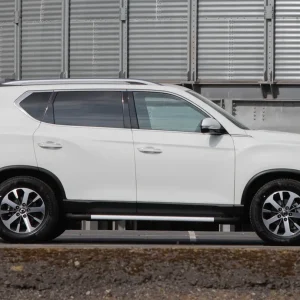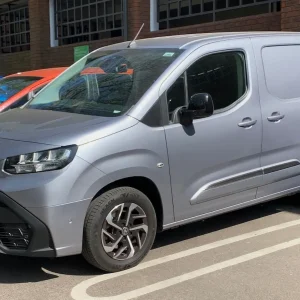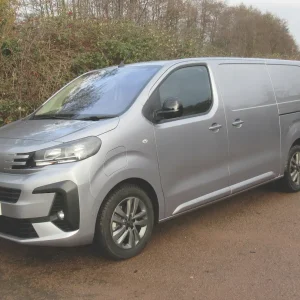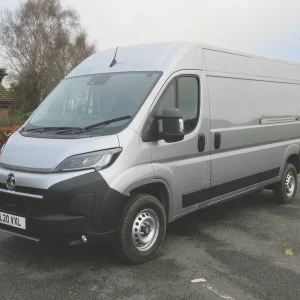In doing so Ford has waved bye-bye to the old 2.2- and 2.4-litre diesels in favour of a new Duratorq
TDCi 2.2-litre used to power rear-wheel, all-wheel and front-wheel drive models.
The new engine is up for grabs in 100, 125, 140 and 155hp guises, with the 140hp option offered solely with front-wheel drive and the 155hp only with rear-wheel drive. A six-speed gearbox is standard in all cases.
With one eye on the need to cut greenhouse gas emissions, Ford has introduced two new low-CO2 front-wheel drive
Econetic derivatives with either a short wheelbase and a low
roof or a long wheelbase and a medium- height roof. They feature an Eco pack that includes stop/start (which kills the engine automatically at the lights and in traffic congestion so that it burns less fuel and causes less pollution), and a 70mph speed limiter, both of which can be switched off. A fixed speed-limiter that restricts the driver to 62mph is listed as an option.
What Van? sampled the short-wheelbase low-roof 100hp T280 Econetic van: it’s not the fastest Transit on the highway, but is one we felt was likely to be kind to wallets and atmosphere alike.
Cab
Although the quality of the materials used and the standard of fit and finish are not all that they might be, at least the Transit’s three-seater cab is not short of storage space.
Facilities include a big bottle holder plus a cup holder at each end of the dashboard, not to mention a hopper-type bin in the middle and a flip-down tray on top with two more cup-holders.
A lidded glovebox with a shelf above is provided too, while the line-up of shelves on top of the fascia includes two with lids, one of which conceals a 12V power point (there’s another 12V point
on the front of the dashboard). Both doors feature a capacious bin. Meanwhile, it’s good to see that Ford provides chunky, easy-to-use controls for the heating and ventilation system.
The driver’s seat is height- adjustable, although the adjustment lever on our demonstrator was somewhat stiff and un-biddable. While we have no reason to quarrel with the driving position – it is comfortable and offers good vision ahead and to either side – sliding across the cab to emerge safely on the pavement side can be a touch problematic because the moulding bulging out of the front of the dashboard that hosts the gear stick gets in the way.
A bit of a squeeze for two, the dual passenger seat offers the inboard occupant limited legroom, and the way in which it projects over the cab entry step can sometimes make climbing out a little awkward.
Load area
Access to the 6.6m³ cargo bay is by means of a sliding nearside door with a step just inside it, plus twin, opaque, rear doors that can be swung through 90º. You can push them through 180º if you release the user-friendly stays.
With eight tie-down points plus near- and off-side lashing
rails at waist height for an extra £60 – all prices exclude VAT – there is no excuse for failing to secure wayward loads. If anything does start sliding forwards, however, then the full-height steel bulkhead should check its progress.
Anybody who buys this van will have to invest in a lining kit, including a covering for the floor. The load bay has next to no protection against minor dents
and scrapes, although we’re pleased to see it has two interior lights, with a 12V power point provided on our test vehicle for an additional £60.
Maximum load length is 2582mm, maximum width is 1762mm narrowing to 1390mm between the wheel boxes, while maximum height is 1430mm. Rear loading height is 538mm. The rear door aperture is 1540mm wide and 1370mm high. Dimensions for the side door are 1030mm and 1352mm respectively.
Grossing at 2.8 tonnes and able to haul a braked trailer grossing at 660kg, our demonstrator could handle a gross payload of 1077kg.
Powertrain
Higher-pressure common rail direct fuel-injection, a new variable- nozzle turbocharger, improved electronic exhaust gas recirculation to help cut emissions and a coated diesel particulate filter are all features of the new intercooled four-cylinder 16-valve 2.2-litre. Top power bites at 3500rpm while maximum torque of 310Nm kicks in at 1300rpm.
In Econetic trim it produces 178g/km falling to 173g/km if you opt for the fixed 62mph speed-limiter.
Chassis and steering
Independent suspension with MacPherson struts and an anti-roll bar helps support the Transit’s front end while leaf springs are installed at the rear. The Econetic rides on 16-inch steel wheels with full covers, and in our case the wheels were shod with 215/75 R16C low rolling-resistance Continental tyres.
Power-assisted steering offers a 10.8m turning circle kerb-to-kerb increasing to 11.4m wall-to-wall.
Performance
One of the slightly restyled Transit’s big plus-points is its top-notch handling. It is remarkably responsive, ensuring that the van heads promptly in whichever direction the driver cares to point
it in with ample feedback through the steering.
Whatever it does, it does it quietly. The technology required to implement Euro5 has had the happy effect of quietening diesels down as well as cleaning up their emissions, and the new 2.2-litre is no exception. The traditional diesel rattle has been banished, with an additional engine top cover and a specially designed cold air duct both contributing to a quieter life. Another factor is the longer gearing, although it is of course primarily intended to keep fuel consumption down.
Make an engine quieter and all the other sources of decibels on a vehicle – wind noise, road roar and so on – may become more intrusive, but in the case of the Transit they are all kept well under control.
On-the-road performance is respectable rather than outstanding, but if you usually run fully laden over long distances or in hilly terrain you may want
to opt for the 125hp diesel instead. Whichever power level you select you will be able to get the best out of the engine thanks to the slick, quick gear change.
Our test Transit bounced about all over the place when it was empty, which at least prompted us to keep our speed down, but adding plenty of weight in the back improves the ride.
Equipment
Complete with an aux-in connection, the radio/CD player boasts decent-sized switchgear too and can additionally be controlled using a remote mounted on the steering column. The package installed in our van included Bluetooth with voice control for £200 while cruise control was provided for a further £150. An onboard computer and electric windows were fitted too. The exterior mirrors had to be adjusted manually alas, although at least they had a separate wide-angle section.
Buying and running
Service intervals are set at one year/20,000 miles and the Transit is protected by a three- year/ 100,000-mile warranty with roadside assistance thrown in for the first year. An eight-year guarantee against body perforation caused by corrosion is provided too.
We averaged 42.0mpg, almost the same as the official 42.2mpg combined fuel economy figure, which is itself 3mpg better than what is on offer from the equivalent standard model. The shift indicator light fitted to the Econetic is set to prompt you to change up earlier than the light on other models and can be of benefit when it comes to holding fuel consumption down, but use your intelligence, treat it as a guide and don’t let it mesmerise you into not concentrating on the road ahead. 
Our demonstrator was finished in metallic paint for an extra £400 but an absence of side rubbing strips and zero protection for the wheel arches made it vulnerable to scratches and scrapes.
Safety
Disc brakes are fitted front and rear along with ABS, electronic stability programme and hill launch assist to stop you rolling backwards when trying to move away on an incline. Like them or loathe them, you get daytime running lights too, of course.
Reversing sensors including a rear step built into the bumper were fitted for an extra £200 while the heated windscreen
aids safety because it makes it less likely that drivers will depart first thing on a winter’s morning without defrosting the glass properly. If all goes wrong, then
at least the driver is protected by an airbag.
A passive anti-theft system (PATS) engine immobiliser should help frustrate thieves as should the key-operated bonnet release – something more manufacturers should adopt. The visible vehicle identification number (VIN) should provide a deterrent too, while remote central locking makes it more likely that all the doors will be locked when the vehicle is left unattended.
Verdict
Nobody ever got shot for buying a Transit and that is as true today as it was 40-odd years ago.
The birth of a legend
Ford’s legendary Transit debuted in 1965, replacing Ford of Britain’s Thames 400E and Ford of Germany’s Taunus Transit. 
Light years ahead of its predecessors and of anything else on the market at the time, it was an immediate sales success thanks to its own virtues and some remarkably astute marketing. The Transit soon accounted for one-in-three sales of medium-sized vans in the UK and was hitting 40% by the mid-1970s. Over the years the Ford Transit has gone through several incarnations (facelifted in 1978, a second-generation Transit 1986, and facelifted 1994) with the biggest change occurring in 2000 when it was introduced in both front- and rear-wheel drive guises. It has been further developed since and is now on sale with Euro5 engines.





